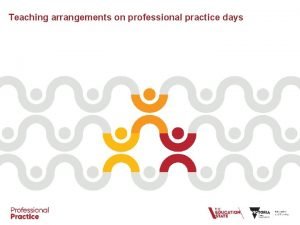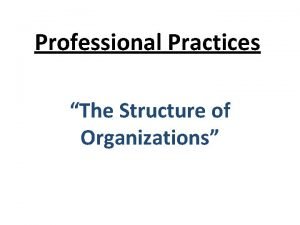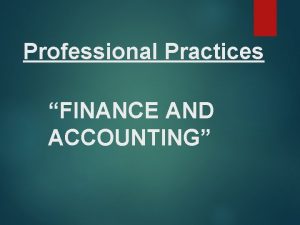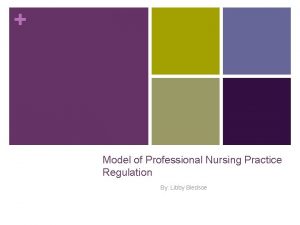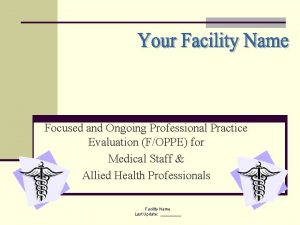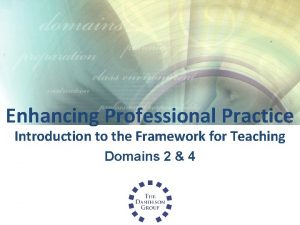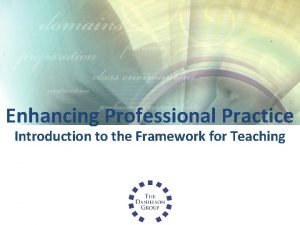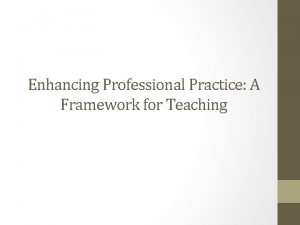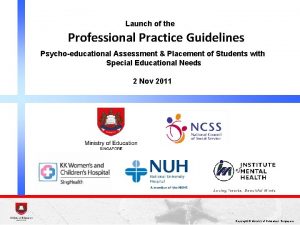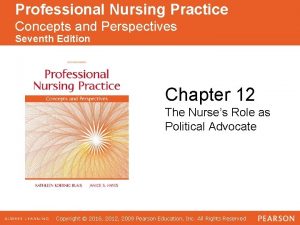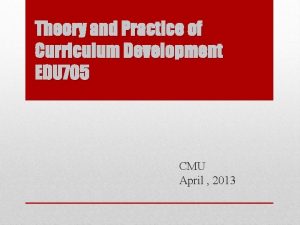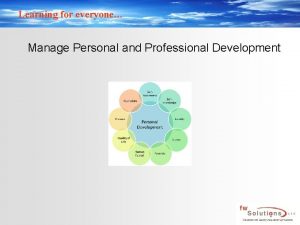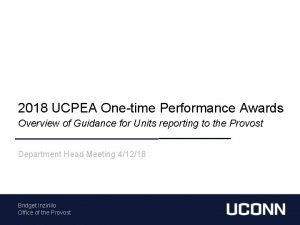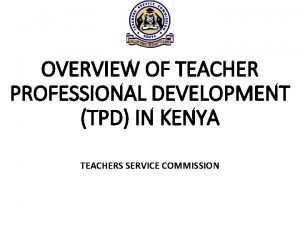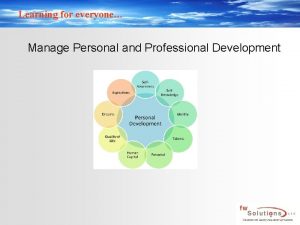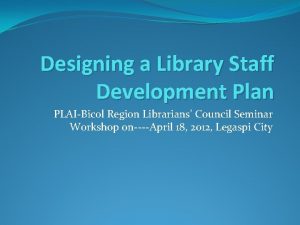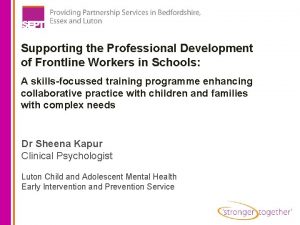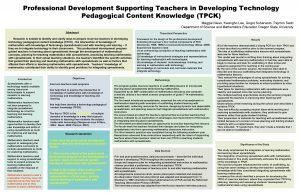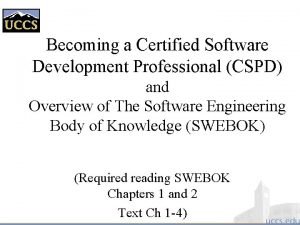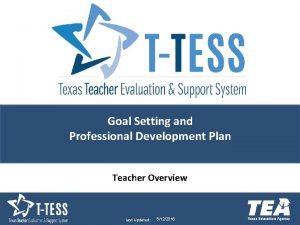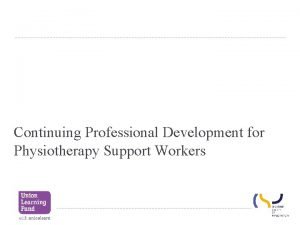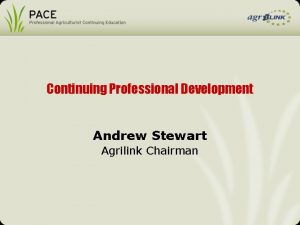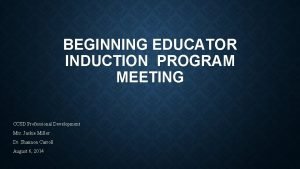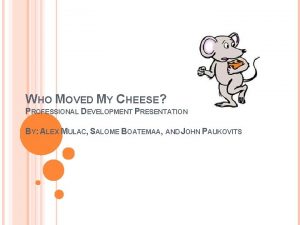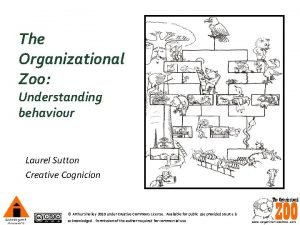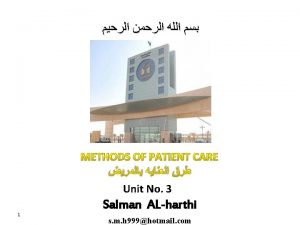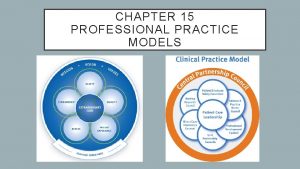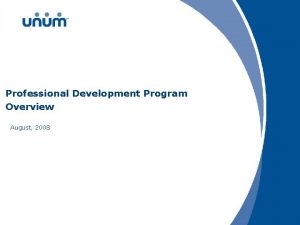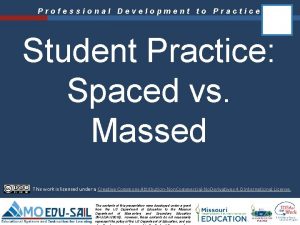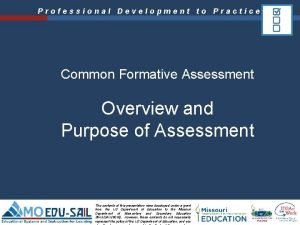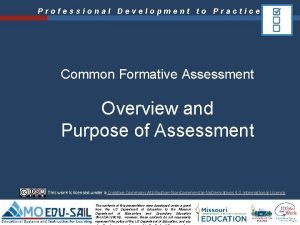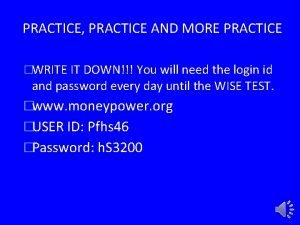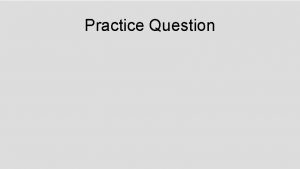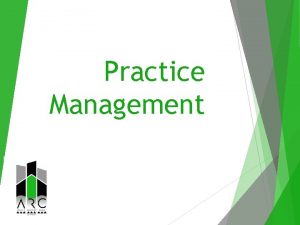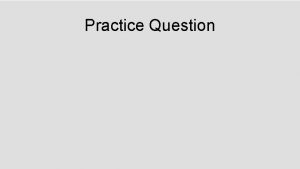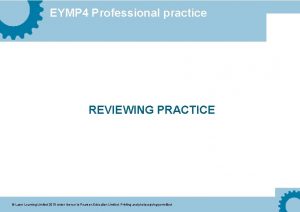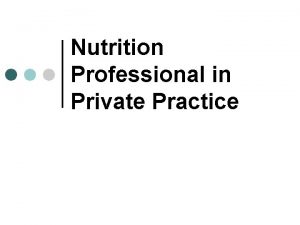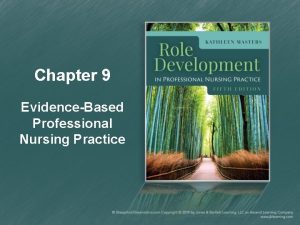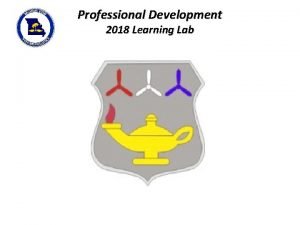Professional Development to Practice Professional Development Overview Professional











































- Slides: 43

Professional Development to Practice Professional Development Overview

Professional Development to Practice Materials Needed q. PPT Presentation Slides Handout (Optional) q. Effect Size Quiz Sheet q. Cluster of Practices Handout q. Reflection Sheet q. Sample Practice Profile (Optional) q. Sample Fidelity Checklist (Optional)

Professional Development to Practice Purpose is very quick overview of…. q. Collaborative Work q. Visual Learning and John Hattie q. Effective Teaching and Learning Practices and Learning Packages q. How the learning packages may be used

Professional Development to Practice PART I Collaborative Work

Professional Development to Practice Why are we doing Collaborative Work? q Recent research has shown us that there are some teaching/learning practices that are highly effective. q To maximize these effects and reach every child, we need to work in collaborative teams to assist one another and to learn and use these practices well. q The Collaborative Work is aligned to the Missouri Teacher/Leader Standards and supports implementation of the Missouri Learning Standards.

Professional Development to Practice Desired outcome from the Missouri Collaborative Work is improved outcomes for all students. Teachers and administrators will implement collaborative data teams to assist one another to: q implement effective teaching/learning practices; q develop and administer common formative assessments that measure the effectiveness of instruction and student mastery of learning targets and; q use data-based decision-making to guide team decisions about classroom learning and instruction.

Professional Development to Practice Collaborative Data Teams Effective Teaching and Learning Practices Common Formative Assessments Data-Based Decision Making Collaborative Data Teams help each other learn to select and use effective teaching/learning practices which are intentionally used to improve student outcomes. Collaborative Data Teams use common formative assessments to monitor the value of the teaching and learning practices and of student acquisition of knowledge and skills. Collaborative Data Teams collectively analyze data to determine who needs more help and what practices are most likely to work for re-teaching. Re-testing validates their decisions.

Professional Development to Practice Series of learning packages developed to support implementation of the CW and effective teaching and learning practices. Collaborative Data Teams Data-Based Decision Making Student-Teacher Relationships Classroom Student Engagement Assessment Capable Learner Feedback Direct Instruction School-Based Implementation Coaching Reciprocal Teaching Common Formative Assessment Effective Teaching and Learning Practices Using Technology in the Classroom Metacognition Student Practice: Spaced vs. Massed Universal Design for Learning Classroom Discussions Differentiated Instruction

Professional Development to Practice PART II Visible Learning

Professional Development to Practice s c i top e h t e r e w w g o n i H n r a e l e ? h t n e s for o h c s e g a k c a p

Professional Development to Practice

Professional Development to Practice http: //www. youtube. com/watch? v=9 ousr 8 u. Kosk Listen closely for what John Hattie says specifically regarding teacher impact.

Professional Development to Practice Maximizing Impact “The biggest effects on student learning occur when teachers become learners of their own teaching, and when students become their own teachers. ” John Hattie

Professional Development to Practice Effect Size – The Research Ruler • Effect size is a method of comparing results on different measures (standardized tests, teacher tests, student work) over time or between groups that allows multiple comparisons.

Professional Development to Practice Standard Deviation +1. 00 -1. 00 MEAN • Students do better than 84% of students not in that initiative • Typically represent 2 years growth in one year

Professional Development to Practice Hattie’s “Barometer of Influence” Medium Hinge Point hp= 0. 40 0. 15 ative Neg 1. 0 s Reverse Effects ect l Desired Effects gh Hi Ef opm fe e ct n s ta Eff -0. 2 el er 0. 0 ev ach D 0. 7 Te Lo w 0. 4 1. 2 © John Hattie Visible Learning

Professional Development to Practice Make an Educated Guess Work alone, with a partner or a small group to determine the “Barometer” placement of high, medium, or low of the practices listed on the Effect Size Quiz Sheet.

Professional Development to Practice Make an Educated Guess HIGH MEDIUM LOW 0. 60 or higher 0. 40 - 0. 59 0. 39 or lower

Professional Development to Practice Rank (x/150) Effect Size High-Medium. Low 131 ? 0. 12 ? Low ? Acceleration 15 ? 0. 68 ? High ? Comprehension Programs 26 ? 0. 60 ? High ? Concept Mapping 27 ? 0. 60 ? High ? Cooperative vs. Individualistic learning 28 ? 0. 59 ? Medium ? Direct Instruction 29 ? 0. 59 ? Medium ? Feedback 10 ? 0. 75 ? High ? 133 ? 0. 12 ? Low ? Influence Ability Grouping/Tracking/Streaming Gender (male vs. female achievement)

Professional Development to Practice Influence Home Environment Individualizing Instruction Influence of Peers Matching Teaching with Student Learning Styles Metacognitive Strategy Programs Phonics Instruction Professional Development on Student Achievement Providing Formative Evaluation for Teachers Rank (x/150) Effect Size High-Medium. Low ? 44 109 ? 41 ? 0. 52 ? Medium ? 0. 22 ? Low ? 0. 53 ? Medium ? 125 ? 0. 17 ? Low ? 14 ? 36 ? 47 0. 69 ? 0. 51 ? ? High ? Medium ? 5 ? 0. 90 ? High ? 0. 54 ?

Professional Development to Practice Ø What surprised you? Ø What do you have questions about? Ø What does this research mean for students and teachers in your - District? Building? Ø What does this research mean for your classroom?

Professional Development to Practice PART III Effective Teaching and Learning

Professional Development to Practice Definition of Effective Teaching/Learning Practices at the classroom level are evidence-based effective methods that are not content related and when implemented with fidelity and informed through data can produce positive, sustained results for every student.

Professional Development to Practice Why Use Effective Teaching/ Learning Practices? Research shows that the ways in which teachers promote ways of thinking through teaching practices can enhance students’ information processing, motivation for learning, and cognitive development. Ames & Archer (1988)

Professional Development to Practice Series of learning packages have been developed to support implementation of the CW and effective teaching and learning practices.

Professional Development to Practice “Clusters of Packages” 3 page handout

Professional Development to Practice Cluster 1: Three Foundational Packages of Collaborative Work Collaborative Data Teams (CDT) Data-Based Decision Making (DBDM) Common Formative Assessment (CFA) (Modules 1 -3) Providing Formative Evaluation Effect. 90 The importance of developing and sustaining a school culture that embraces the use of teams, data and collaboration for continuous school improvement. The effective implementation by teams of protocols, processes and tools in order to accomplish the tasks on hand (i. e. agendas, minutes, dialogue, and discussion, norms, logistics, consensus, roles, decisionmaking skills, and protocols). A six-step process or protocol that allows collaborative data teams to use common formative assessment results to make “data-driven” decisions about changes to curriculum, instruction and/or assessment. The basics of assessment design. The principles of sound assessment design. Data teams use a backwards design process and a template form to develop a Common Formative Assessment.

Professional Development to Practice Cluster 2: Two Packages that are the Pre-requisites for Learning Student Teacher Relationships Effect. 72 Engaging Student Learners Effect Engagement. 48 The elements/practices of a strong, positive student-teacher relationship that fosters high intellectual performance. Adult behaviors that have a high degree of positive influence for the development of positive student-teacher relationships. Ideas on how a strong, positive student-teacher relationships are promoted. Connecting student motivation to student engagement. The components of high student engagement. The actions, practices, strategies, and techniques that promote high engagement for all learners. Assessing lessons and units for engaging qualities.

Professional Development to Practice Cluster 3: Three High Effect Packages that Should Be Addressed Simultaneously Assessment Capable Learner (ACL) Effect 1. 44 Feedback Effect. 73 Developing assessment capable learners. Strategies to teach students to be assessment capable learners. How to apply those strategies to all leaners, all grade levels, and all content areas. Help students answer: Where am I going? Where am I now? How do I close the gap? The role feedback plays in creating assessment capable learners. Hattie’s four levels of feedback. The strategies for effective feedback implementation. The prerequisites to giving feedback to students and seeking feedback from them. Metacognition The role metacognition (also called reflection) plays in creating Effect. 69 assessment capable learners. Learn the meaning of metacognition and how it is used. Creating a culture of metacognition in the classroom by learning strategies that teach students to be metacognitive.

Professional Development to Practice Cluster 4: Four Learning Packages That Fit in One or More Steps in the Direct Teaching Process Direct Instruction Effect. 59 Application of the principles of Direct Instruction in the classroom/building and effective implementation of the seven steps involved in the Direct Instruction process. Student Practice: Spaced vs. Massed. 71 An understanding of the “practice “step of the direct instruction process. Various types of practice sessions, when students should practice and the amount of practice needed. Prerequisites for successful student practice. Planning effectively to ensure students benefit from practice sessions. Reciprocal Teaching. 74 Classroom Discussion Where reciprocal teaching fits into the process of direct instruction. The reasons reciprocal teaching is an important instructional practice. The core components and implementation steps involved in reciprocal teaching. How reciprocal teaching looks within various content area classrooms. Where discussion fits into the Direct Instruction process. Expand knowledge of classroom discussion and the core components and implementation steps involved. Learn what implementation looks like in classroom practice.

Professional Development to Practice Cluster 5: Two Packages That Can Be Tied to the Direct Teaching Process AND Help Teachers Meet the Diverse Needs of ALL Learners Universal Design for Learning Differentiated Instruction Universal Design for Learning to meet the needs of all learners. Three guiding principles that emerged from the three primary brain networks. Principle I: Provide Multiple Means of Representation Principle II: Provide Multiple Means of Action and Expression Principle III: Provide Multiple Means of Engagement Expansion of repertoire of instructional strategies that support universal design for learning. The key principles of differentiated instruction and how it fits into the process of direct instruction. Examine teaching practices that differentiate content, process, and/or product according to students’ needs. Expansion of repertoire of instructional strategies that support differentiated instruction.

Professional Development to Practice Cluster 6: Three Learning Packages for Enhancement Common Formative Assessment (Modules 4 -6) Using Technology in Instruction School-Based Coaching Module 4: High quality selected response items to measure higher level thinking skills. Module 5: High level constructed response items and how to score responses consistently and objectively. Module 6: High level, authentic performance tasks and how to score performances consistently and objectively. Ways national standards for teachers and students and the 21 st Century Skills impact the implementation of technology in the classroom. The three pyramids for technology integration. Implementation of using technology in classroom instruction and with effective teaching and learning practices. The purpose of, the role and responsibilities of the school-based implementation coach. The ability to match expertise with school-based implementation coaching needs. Challenges and potential barriers to implementing the school-based coaching process.

Professional Development to Practice Which of the learning package clusters best meets the needs of your team? Why?

Professional Development to Practice Fidelity of Implementation is Essential

Professional Development to Practice Only when effective practices are fully implemented should we expect positive outcomes. Implementation matters. Blase & Fixsen, 2005, p. 10

Professional Development to Practice Fidelity Implementation Checklists have been developed for each learning package.

Professional Development to Practice Profiles Have Been Developed for Each Learning Package

Professional Development to Practice Small Group Brainstorm q. What might be done to ensure fidelity of implementation? q. Work with a small group to generate ideas. q. Be ready to share.

Professional Development to Practice How do your ideas compare to these? q Provide comprehensive training and support materials for staff with opportunities for practice and corrective feedback included in the training plan. q Develop “calibration checks” for teachers to use to monitor their own implementation (Gunn, n. d. , online). q Include principals in training with emphasis on what the program looks like in practice so they can provide effective and ongoing monitoring and feedback. q Develop a plan for monitoring implementation that includes data collection, observation of the program as implemented, analysis of the data, and planning for ways to address off-target implementation or “poor-fidelity drift. ” q Use the fidelity data to identify possible reasons for programs not performing as expected. q Adapted from “Monitoring Fidelity of Implementation, Center on Innovation and Improvement, ” n. d.

Professional Development to Practice PART IV Making Connections

Professional Development to Practice 1 Foundational Learning Packages: Collaborative Data Teams, Data-based Decision Making and Common Formative Assessment (Modules 1 -3) 2 Pre-requisite to Learning Packages: Teacher-Student Relationships and Engaging Student Learners 3 High Effect Learning Packages: Assessment Capable Learner, Feedback and Metacognition 4 Connected to Direct Instruction Packages: Direct Instruction, Student Practice, Reciprocal Teaching, Classroom Discussion 5 DI and Diverse Needs Packages: Universal Design for Learning, Differentiated Instruction 6 Enhancement Packages: Using Technology in the Classroom, Common Formative (Modules 4 -6), School. Based Coaching

Professional Development to Practice What are some other possible scope and sequences that might work well for your team and/or building? Be ready to share ideas with the group?

Professional Development to Practice Personal Reflection One thing that excites me is…. One thing that worries me is. . . One thing I would like to do first is…
 Myeplg
Myeplg Professional practice days
Professional practice days Structure of organization in professional practice
Structure of organization in professional practice Professional practice finance
Professional practice finance 5 levels of prevention leavell and clark
5 levels of prevention leavell and clark What do you mean by professional
What do you mean by professional Model of professional nursing practice regulation
Model of professional nursing practice regulation Ongoing professional practice evaluation template
Ongoing professional practice evaluation template Enhancing professional practice
Enhancing professional practice Enhancing professional practice
Enhancing professional practice Tpess training
Tpess training Enhancing professional practice: a framework for teaching
Enhancing professional practice: a framework for teaching Moe professional practice guidelines
Moe professional practice guidelines Political astuteness in nursing
Political astuteness in nursing It is to conform to accepted professional practice
It is to conform to accepted professional practice Daniel tanner 1980 definition of curriculum explanation
Daniel tanner 1980 definition of curriculum explanation Cpd law ra 10912
Cpd law ra 10912 7 norms of collaboration
7 norms of collaboration Rockefeller college professional development program
Rockefeller college professional development program Learning and development plan for teachers
Learning and development plan for teachers Manage personal and professional development
Manage personal and professional development Professional development norms
Professional development norms Personal growth and professional development.
Personal growth and professional development. Domain 6 of ppst
Domain 6 of ppst 4 stages of professional development
4 stages of professional development Ucpea professional development
Ucpea professional development Professional development pathway
Professional development pathway Kenya professional teaching standards
Kenya professional teaching standards Nmpdc
Nmpdc Manage personal and professional development
Manage personal and professional development Excelsior scholarship contract
Excelsior scholarship contract Library development plan sample-philippines
Library development plan sample-philippines Frontline professional development
Frontline professional development Quote about professional development for teachers
Quote about professional development for teachers Professional development
Professional development Initial professional development
Initial professional development Certified software development professional
Certified software development professional Teacher professional development plan template texas
Teacher professional development plan template texas Continuing professional development
Continuing professional development Continuing professional development
Continuing professional development Continuing professional development
Continuing professional development Ccsd professional development
Ccsd professional development Who moved my cheese presentation
Who moved my cheese presentation Zoo organizational structure
Zoo organizational structure

